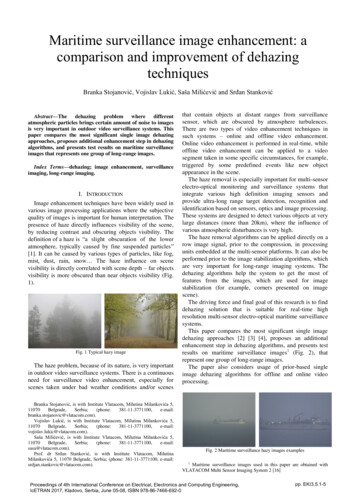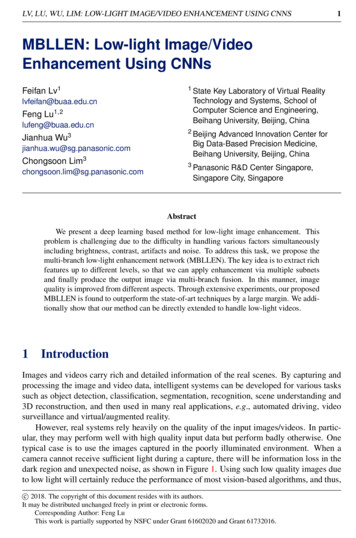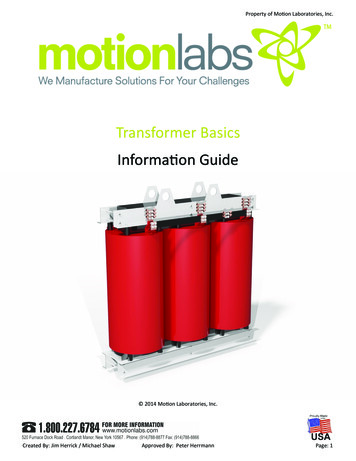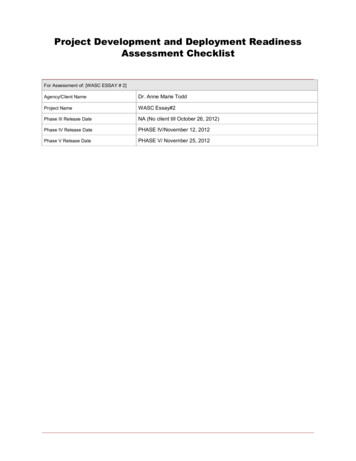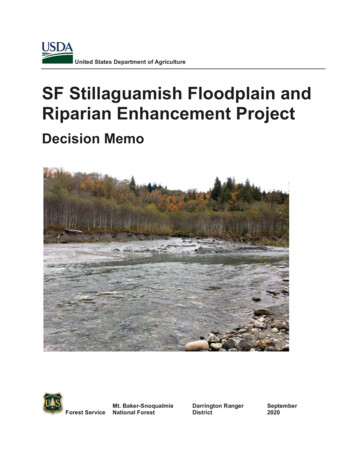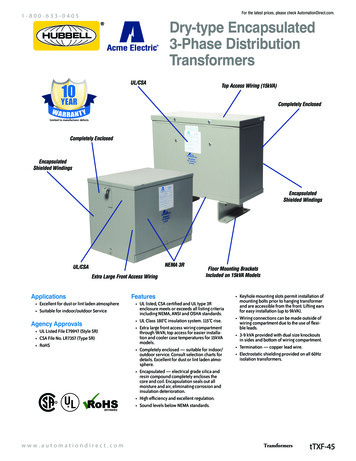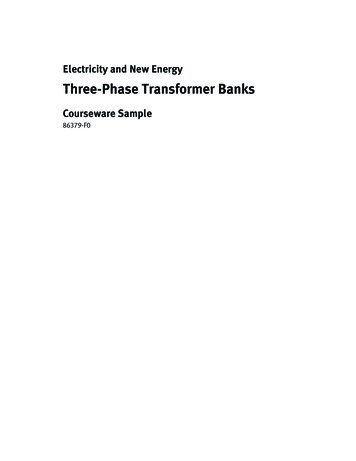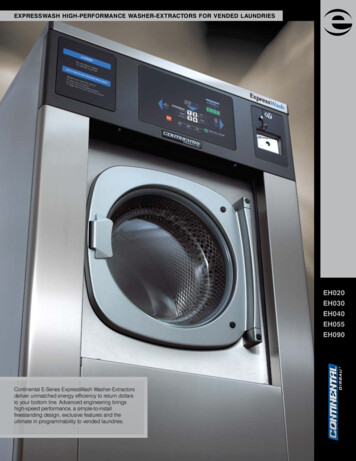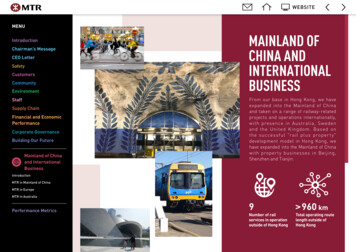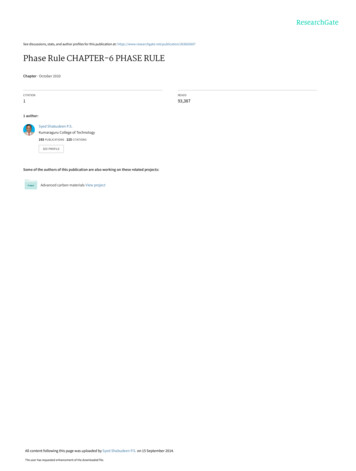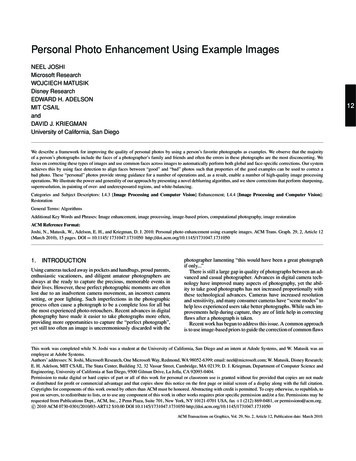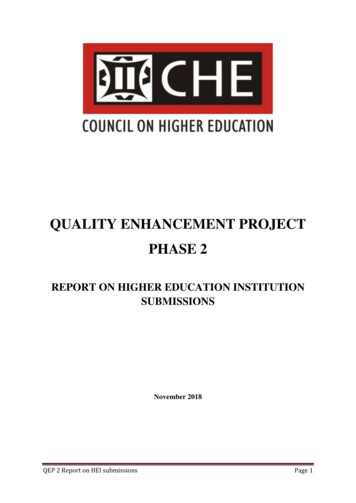
Transcription
QUALITY ENHANCEMENT PROJECTPHASE 2REPORT ON HIGHER EDUCATION INSTITUTIONSUBMISSIONSNovember 2018QEP 2 Report on HEI submissionsPage 1
ContentsAbbreviationsIntroductionInstitutions that submitted QEP 2 responsesStructure of the ReportSection 1. Curriculum renewal and transformation at the institutional levelSection 2. Diversity and inclusivitySection 3. Curriculum development capacity and qualitySection 4. Student and stakeholder participation in curriculum design anddevelopmentSection 5. Any other commentsAnnexure A. Institutional submission templateQEP 2 Report on HEI submissions3579103652576875Page 2
EQMUTNATEDNMUNRFNQFNSFASNWUODeLODLOLGAAA School of Advertising (Pty) LtdBusiness Management Training College (Pty) LtdBoston Media HouseChartall Business College (Pty) LtdCouncil on Higher EducationChartered Institute of Management AccountantsCityVarsity (Pty) LtdCollege of Transfiguration, NPCCape Peninsula University of TechnologyCentral University of TechnologyDamelin (Pty) LtdThe Da Vinci Institute of Technological Management (Pty) LtdDermatechDepartment of Higher Education and TrainingDurban University of TechnologyExtended Curriculum ProgrammeEngineering Council of South AfricaFull-Time EquivalentHigher Education InstitutionHigher Education Quality CommitteeHigher Education Qualifications Sub-FrameworkHealth Professions Council of South AfricaICESA City CampusThe Independent Institute of EducationInscape Education GroupLesbian, Gay, Bisexual, Transgender, Intersex, Questioning, AlliedLyceum College (Pty) LtdMediClinic (Pty) LtdMilpark EducationMonash South AfricaMassive Open Online CourseMinimum Requirements for Teacher Education QualificationsMangosuthu University of TechnologyNational Accredited Technical Education DiplomaNelson Mandela UniversityNational Research FoundationNational Qualifications FrameworkNational Student Financial Aid SchemeNorth-West UniversityOpen Distance e-LearningOpen Distance LearningOpen Learning Group (Pty) LtdQEP 2 Report on HEI submissionsPage 3
PG e DiplomaProgramme and Qualification MixQuality Enhancement ProjectRichfield Graduate Institute of Technology (Pty) LtdRhodes UniversityRed and Yellow Creative School of Business / School of Logic & MagicStellenbosch Academy of Design and Photography (Pty) LtdSouth African Institute of Chartered AccountantsSouth African Qualifications AuthoritySefako Makgatho Health Sciences UniversityStellenbosch UniversityTheological Education by Extension College NPCTshwane University of TechnologyUniversity of Cape TownUniversity of Fort HareUniversity of JohannesburgUniversity of KwaZulu-NatalUniversity of LimpopoUniversity of MpumalangaUniversity of South AfricaUniversity of TechnologyUniversity of PretoriaUniversity of the Western CapeUniversity of the WitwatersrandUniversity of ZululandVaal University of TechnologyWalter Sisulu UniversityQEP 2 Report on HEI submissionsPage 4
IntroductionThe first quality assurance cycle conducted by the Council on Higher Education (CHE) tookplace between 2004 and 2011. The key activity was audits of higher education institutions(HEIs). During this cycle there were considerable developments within the sector: merging ofexisting and creation of new institutions, and the development of new quality assurancemechanisms. At the end of the audit cycle, discussion took place between the CHE and the HEIsector about the focus, scope and direction of a second cycle. An external evaluation of theCHE in 2009 noted the benefits of the institutional audit process, but also the cost in time andhuman resources. It suggested that the next cycle should focus on quality promotion and, indiscussion with HEIs, the need to improve teaching and learning emerged as a central theme.By the end of 2013 that the focus of the second quality assurance cycle would be on improvingstudent success, both at individual institutions and across the higher education sector as awhole. This resulted in a Quality Enhancement Project, which aims to ‘help institutions toadvance to increasing levels of quality’.In its introduction to the project, Quality Enhancement Project Phase 2: Focus Area andInstitutional Submission Specifications (Public Universities) of March 2017, the CHEidentified the focus area of QEP Phase 2 as curriculum. While acknowledging that the term‘curriculum’ is highly contested and that there are different interpretations, it defined‘curriculum’, for the purposes of the project, as ‘the structure and processes that frame thelearning opportunities provided to students’ (CHE, 2017, 8). It notes that curriculum in thehigher education sector has recently come under heightened public scrutiny as a product ofpolitical activism that often commenced under the banner of other, indirectly-related issues:thus the decision to make curriculum the focus of QEP 2.The CHE introduction identifies three facets of curriculum. They are: curriculum structure, including the components, usually identified as courses ormodules with credit values, outcomes, associated rules and regulations, and thearrangement of components including pre-requisite and co-requisite requirements; curriculum content, namely what is explicitly or implicitly contained in the curriculum,influenced by factors such as ideology, power relations, educational philosophy,institutional mission and values, disciplinary characteristics and priorities, and therelations between components and the purpose of the learning programme as a whole;and curriculum implementation, the engagement with students, including institutionalpolicies and allocation of human and physical resources, expertise of lecturers andtutors, pedagogical approaches, assessment, and the environment in which teaching andlearning takes place. (CHE, 2007, 14)Institutions were asked to frame their responses in terms of those three facets: curriculumstructure, content and implementation.QEP 2 Report on HEI submissionsPage 5
There was, for the project, both an institutionally internal and external purpose. The internalpurpose was to provide institutions with an opportunity to reflect on, evaluate and documenttheir own choices and experience related to curriculum matters. The external purpose was toprovide information, via the CHE, to the higher education sector that could form the basis forshared insight and, resulting from that, a system-wide enhancement of curriculumconceptualisation, design, delivery, review and renewal. It is to the latter purpose that thissynthesis report is directed.The Focus Area document of March 2017 was sent to public higher education institutions(HEIs) via Deputy Vice-Chancellors (Academic/Teaching and Learning) for comment. Aconsultative meeting with the Private Providers Working Group was held on 31 May 2017.After endorsement by the Institutional Audits Committee and approval by the HigherEducation Quality Committee (HEQC), a final submission template was disseminated on 29September 2017.The structure of the submissions – the topical sections and accompanying questions – sent topublic HEIs is included as Annexure A. The main topics sent to private HEIs were identical,although there were small differences in the questions; the differences are noted at relevanttimes in this report.The due date for submission was 30 November 2017. In some cases a short extension wasgranted. By February 2018 the CHE has received submission from 23 public HEIs and 21private HEIs.QEP 2 Report on HEI submissionsPage 6
Institutions that submitted QEP 2 responsesPublic HEIsCape Peninsula University of TechnologyCentral University of TechnologyDurban University of TechnologyMangosuthu University of TechnologyNelson Mandela UniversityNorth-West UniversityRhodes UniversitySefako Makgatho Health Sciences UniversityStellenbosch UniversityTshwane University of TechnologyUniversity of Cape TownUniversity of Fort HareUniversity of JohannesburgUniversity of KwaZulu-NatalUniversity of LimpopoUniversity of MpumalangaUniversity of South AfricaUniversity of PretoriaUniversity of the Western CapeUniversity of the WitwatersrandUniversity of ZululandVaal University of TechnologyWalter Sisulu UniversityPrivate HEIsAAA School of Advertising (Pty) LtdBusiness Management Training College (Pty) LtdBoston Media HouseChartall Business College (Pty) LtdCityVarsity (Pty) LtdCollege of Transfiguration, NPCDamelin (Pty) LtdThe Da Vinci Institute of Technological Management (Pty) LtdDermatechICESA City CampusThe Independent Institute of EducationInscape Education GroupLyceum College (Pty) LtdMediClinic (Pty) LtdQEP 2 Report on HEI submissionsPage 7
Milpark EducationMonash South AfricaOpen Learning Group (Pty) LtdRichfield Graduate Institute of Technology (Pty) LtdRed and Yellow Creative School of Business / School of Logic & MagicStellenbosch Academy of Design and Photography (Pty) LtdTheological Education by Extension College NPCQEP 2 Report on HEI submissionsPage 8
Structure of the ReportThe CHE provided institutions with a submission template, comprising questions arranged infour sections. The sections were:1.2.3.4.Curriculum renewal and transformationDiversity and inclusivityCurriculum development capacity and qualityParticipation in curriculum design and development.In the case of public HEIs a length of 5 – 10 pages was suggested for each section. The lengthof submissions varied significantly from 11 to 83 pages. Consequently, the amount of detailand the number of exemplars of practice varied accordingly. While length was not in itself thesole indicator of the scale of enquiry, it would account partially for the fact that some HEIs arereferred to in this report more frequently than others. In the case of private HEIs a limit of 4000 characters was set for each of the questions; any further information was to be sent byseparate e-mail.Although there were no direct comments in the submissions on the requested structure of thereport, it is clear that, in many cases, the writer(s) of a report experienced some, and sometimessignificant, overlap between the sections and, often more so, between the questions. (Anexample was difficulty in responding separately to the concepts ‘diversity’ and ‘inclusivity’.)The result was considerable repetition, of topic or supporting data or both. This report follows,as far as possible, the structure of the CHE template, arranged namely by section and question.Where a submission has duplicated information, or presented it under a section or questiondifferent from the majority of respondents, reference has been adjusted accordingly in theinterests of coherence. There are cases, however, where an institution felt it needed to repeatinformation in order to ensure a comprehensive and coherent response to each question. Thathas, as far as possible, been taken into account.Where submissions include descriptions of policies or procedures that would be consideredstandard in higher education (such as a typical institutional management structure, anassessment policy, or a grievance procedure), the report does not itemise every instance of suchdescription. Instead, it refers, where relevant, to cases where such standard practice is modifiedby one or other distinctive characteristic. In those cases, the institution is identified. In certaincases where a particular aspect has been introduced in many institutions references areexemplary rather than exhaustive.This report is descriptive, based on the submissions. Apart from a necessary selection ofinformation based on its relevance to the question being addressed and of exemplars based onevidence presented of innovation and responsiveness to the issues, the report makes no attemptat discrete or comparative evaluation. At the end of each of the four sections referred to above,a brief summary is offered of the main trends emerging from the institutional submissions.QEP 2 Report on HEI submissionsPage 9
Section 1: Curriculum renewal and transformation at theinstitutional level1.1a) Institutional approach to addressing curriculum renewal andtransformationConceptualising renewal and transformationMany submissions included prefatory comments on the concepts ‘renewal’ and‘transformation’.Educational renewal is more than a process expanding the boundaries of existing knowledge.In an alternative conception, its key intention is ‘to realise better forms of social justice’ by‘changing the matter of social inequities that are reinforced by the curriculum selections of thepast.’ Its aim is to ‘dismantle the edifices which prop up the dominant hegemonic worldviews’.It implies epistemological diversity, and renewal not only of the scope and depth of knowledgebut also of associated pedagogy and classroom practice, and it requires an institutional cultureof openness and critical reflection. Curriculum renewal needs to take account not only ofepistemological and pedagogical innovations, but also shifting trends in the economy, thepolitical landscape, as well as constructive and disruptive changes in new technologies. Inaddition to that, renewal involves ‘grounded elements’: teaching and learning spaces andequipment, and teacher profiles. Matters like diversity and inclusivity are not separate fromthis issue: they are institutional features through which curriculum can be renewed.Transformation in higher education requires a sound, critical responsiveness to intellectualhistory and the power relations that have influenced it. It involves changes to curricula basedon ‘northern and global rationality and instrumental logic perpetuating dominant culturalassumptions and particular epistemologies’. There is no doubt that recent student activismtriggered a comprehensive review of the very concept ‘curriculum’.The calls for decolonisation of the curriculum were designed primarily around the premise of exploringhow certain epistemic traditions perpetuate hegemonic practices to the exclusion of others in theacademy. New questions about what kinds of knowledge, whose knowledge, and what gets privilegedwere now in the spotlight. Instead of a narrow definition of curriculum (small c), discussion now centredon curriculum with a big C, encompassing broader aspects such as pedagogy, assessment, representation,symbols, naming of buildings, language, diversity and so on.Curriculum review must include attention to race, race theory, gender, social change, and ahost of related issues, and presupposes transformation of the institution itself. This includesinstitutional culture, pedagogy, students’ experience of teaching and learning, residence life,and other factors. The academic project needs to interrogate the way curricula ‘marginaliseparticular identities’; in embracing those identities the project must be linked with improvedsuccess rates for students.The academic project has been ‘deprived and distorted’ by past inequalities ‘that continue tobe perpetuated, often in imperceptible ways’; to address meaningfully such deprivation anddistortion, transformation has to go beyond superficial piecemeal interventions that haveQEP 2 Report on HEI submissionsPage 10
merely rhetorical value. It involves re-conceptualisation and revision of hierarchiestraditionally embedded in knowledge systems: re-centering African and other non-Westernknowledge systems embodying, amongst other features, ‘humanness in line with uBuntu’ – butit must go much further than mere reference to other systems or the replacement of names.Renewal is not simply about ‘swopping old voices for new’, adding to or subtracting from whatcurrently is contained; it requires a fully integrative approach. Delivering and assessing newcontent in old ways is unlikely to transform the learning experience. But transformation is notlimited to what happens in the formal classroom: ancillary activities such as communityengagement and work-integrated learning also have an impact. Teaching and learning need tobe infused with associated, appropriate community engagement and research. While, in manycases, enhancing the ‘African character’ of higher education has already commenced, hadindeed in some cases preceded recent student protests, it is premature to claim clear evidenceof success. ‘Fundamental and purposeful’ transformation is a matter of ‘continuous renewal’.According to an institutional transformation charter,Cultural change requires the creative disruption and rupture of entrenched ways of thinking, acting,relating and performing within the institution and a willingness to adapt. Institutional change entails thereconfiguration of systems, processes, structures, procedures and capabilities to be expressive oftransformational intent. Transformation is monitored, milestones agreed, progress evaluated andmeasured, with individual and collective accountability for clearly defined responsibilities,and this has both short-term and longer-term priorities and outcomes.In the current context, transformation is closely associated with the imperative ofdecolonisation. There is consensus among institutions that decolonisation is inextricably linkedto redress of past oppression, and the accompanying pursuit of social justice. Oneunderstanding of decolonisation is thatit is an issue of redress for past and current racial inequalities that have resulted in the marginalisation ofcertain groups in society in terms of their access to knowledge and being recognised as being of value inthe university; for example in their representivity in lectures, tutorials and beyond to more generalacademic life. This links to a social justice approach to teaching.Decolonisation embraces various types of knowledge ‘regardless of their origins’. Butdecolonisation has no end-point: it is ‘not a destination but an ongoing process’. For this reasonthere is a continuous need for new research in educational epistemology.A radical approach to transformation must acknowledge that it comprises more than anaccretion of previously ignored systems onto an unchanged core; it implies curriculardisruption: the dismantling of hegemonic worldviews, the ‘creative rupture of entrenched waysof thinking, acting, relating and performing within the institution’, and a ‘dismantling’ ofentrenched pedagogical strategies. Besides being ‘creative’, disruption needs to be responsiveto social context and to recognise epistemological diversity: some disciplines are moreamenable to ‘theorising’ curriculum transformation than others; the latter types have more‘codified’ and stable bodies of knowledge. As one submission put it, some disciplines – anddepartments – experiment with clear theoretical approaches, while others are more influencedby discipline-specific frameworks.QEP 2 Report on HEI submissionsPage 11
Nevertheless, no discipline can be entirely excluded: theological transformation is as importantas in any other field. It was suggested that, taking into account the largely autonomous statusof academic fields and disciplines, the main role of institutional management should be todevelop clear frameworks, disseminate examples of good practice, support academics to makeeffective contributions to curriculum design, development and renewal, and to enhanceinstitutional capacity to achieve its goals. Whatever the outcomes of the transforming process,there remains an imperative to balance growing calls for vocationalism of programmes(prioritising contextual coherence) with the need for students’ access to ‘powerful knowledge– conceptual coherence’. While the overt teaching of ‘powerful knowledge’ as being a majorthrust in higher education is echoed elsewhere, Muller (2007) is cited as arguing that an overemphasis on the conceptual-contextual duality tends to overlook the really ‘powerful’knowledge, namely ‘relational’ knowledge: the combination of propositions with practice todevelop new praxis. An alternative triad of ‘knowing, doing and being/becoming’ is elsewheresuggested.The aims of renewalSubmissions included a number of thoughts on the main aims of curriculum renewal.Transformation of curricula needs to be accompanied by transformation of teaching andlearning, assessment, cultural orientation and personal disposition (SADP). Innovative,responsive design principles should enhance social cohesion and diversity in (and outside) theclassroom. National goals of redress should go hand in hand with global competencies, suchas outlined in UNESCO 21st century skills protocols. Transformation is about ‘humanising’pedagogy, informed by the views of theorists such as Paulo Freire and Es’kia Mphahlele.Renewal aims for national legitimacy as well as international recognition, thereby addressingthe DHET mandate for higher education. Decolonisation is linked with responses to SouthAfrican, sub-Saharan and global contexts. Local (provincial) priorities – such as health,education, rural development, food security, job creation and sustainability - cannot beoverlooked. What is needed is a balance between Western epistemologies and local knowledgeconstructs incorporating indigenous knowledge systems, creating a dynamic African universityand higher education sector. Indigenous knowledge systems (IKSs) must be reflected not justin epistemology but also in accompanying research, pedagogy and community engagement.The result is a mitigation of the dominance of imported canons, and creation of ‘a multitude ofvoices, canons and diversity in thought’. One concrete innovation to address this aim is thecreation of a ‘Pan-Africa’ Centre for Critical Intellectual Enquiry, which intends to capitaliseon its advantageous location in a major metropolitan area with its broad African demographicand cultural context.DifferentiationOne submission commented that the private sector has not been generally under the samepressure as the public sector to bring about curriculum transformation; it ‘has not felt the callto decolonise or Africanise its curricula’, and accounts for the absence of pressure to its studentprofile: distance-mode learners mostly older than the typical contact-mode undergraduateQEP 2 Report on HEI submissionsPage 12
student. This view was not widely represented, either within the private sector as a whole, orby distance-mode providers. Many traditionally contact-mode institutions have commenced,or are in process of commencing, distance- or blended-mode teaching and learning in response,or as reaction, to recent student protests and the disruption of campus-based classes. This isdiscussed in more detail below.A number of submissions commented on institutional differentiation in the public sector. Manyuniversities of technology remarked on the characteristic role they played, or are expected toplay. A UoT ‘is a university first’: narrowly-focussed curricula to produce graduates withindustry-specific skills is itself a colonial legacy. There is need to foster life-long learning withappreciation of diverse paradigms and contexts. It entails a critical paradigm shift fromprescribed technical curricula (that resulted in polarisation and presumed hierarchies) toenabling graduates to participate fully as critical citizens and to be employable professionals‘in a still fragile democracy’. A ‘historical social upliftment mandate’ persists to this day.Others, while recognising the need for UoTs to cater for increasingly varied and complex postuniversity environments, regard connecting the university, workplaces and society as the‘primary function’ of a UoT. Curriculum renewal and transformation were, in some instances,equated with institutional renewal, namely the new role played by UoTs as the sector changedfrom ‘convenorship’ of ready-made programmes to being autonomous curriculum designers.The need for migration of qualifications from NATED to the HEQSF is partly the reason thatthere has been not enough time to interrogate decolonising the curriculum and ‘radicaleconomic transformation’.In comprehensive institutions, there has been a merger of two different qualification types, andtwo different approaches to curriculum development. There has been a need to transformcurricula to be in line with a distinctive comprehensive-institutional mission: ‘renewal toincrease career education programmes’, and a PQM that balances formative and professionallyoriented with technologically-oriented programmes.External driversPrior to 2015, institutional mergers had a significant impact on curriculum transformation.There has also been considerable pressure on HEIs for alignment of programmes with theHigher Education Qualifications Sub-Framework that sometimes did not allow for in-depth‘true’ transformation. In one case a target date, 2020, has been set for completion of thealignment. In Education a similar external driver was the Minimum Requirements for TeacherEducation Qualifications, while Bachelor degrees in Social Work and Law were subject toCHE national reviews. One example of a PQM realignment process involved the reduction of1 400 programmes to 600, with doctoral programmes reduced from 167 to 37: creatingenormous pressure on staff. Often cited was the National Plan for Higher Education (2001)promoting access, equity and fair opportunities for all students, as well as for workers,professionals, and people with disabilities.Professional bodies with statutory powers to set their own criteria for recognition ofqualifications also play a significant role. Comprehensive universities have had to reQEP 2 Report on HEI submissionsPage 13
curriculate their diploma to degree qualifications to satisfy the requirements of professionalbodies. The workplace, too, has influence, with its increasing demand for competent ‘softskills’ in graduates and its influence via industry-related forums, publications and thedevelopment of new niche markets (Derma, Lyceum). There is, at the same time, pressure onthe curriculum structure exerted by changes in the entering student profile. One institutionremarked on a considerable increase in enrolment from lower-quintile schools, with decreasefrom the upper quintiles, and that this requires a ‘complex and contested reimagining’ ofcurriculum content, shape and form. The demand for reform is coming, in fact, not only fromincreasingly diverse student, but also staff, profiles. Besides disciplinary development, industryneeds, programme reviews and re-alignment, it is acknowledged that student movements suchas #RhodesMustFall – in some cases endorsed by staff – have been major catalysts for renewaland transformation: a new driver alongside traditional ones.Institutional ethosThere have, in some institutions, been innovative internal approaches encouraging curriculumtransformation. Transformation charters, institutional strategies, revised curriculumdevelopment and review policies, quality assurance policies: these speak to institutionalrecognition of the need for renewal, and programme review will explicitly be asking abouttransformation. Staff incentives are being put in place. Teaching to enhance the quality ofstudent experience has been incorporated in criteria for staff promotion, and thresholdcompetence in both teaching and research is required. In the same institution it is, as from 2017,a requirement for all colleges to submit to Senate their curriculum transformation frameworksand, in another, an institutional policy on reimagining curricula for a just society is beingcomplemented with faculty-level curriculum transformation plans. Teaching buy-out time isbeing allocated to curriculum ‘champions’. A culture of intellectual enquiry is being inculcatedin which students can participate more, and space is provided for staff members to have thefreedom to design and adapt curriculum structure, renew content, and improve implementation.Review processesInstitutions have their own internal processes for programme review. Besides minormodifications by departments based on annual internal and/or external moderation or, in somecases, student evaluation of courses, a typical pattern is a review of every programme during acycle of three to seven years. Some institutions require from the programme a self-evaluationreport which is assessed by either internal or, in addition, external experts. Review processesare sometimes accompanied by quality assurance workshops; of particular significance areinter-faculty renewal workshops, designed to stimulate inter-disciplinary conversations. Aninstitutional programme renewal project identifies candidate programmes from each facultyplus a couple of key modules in the programmes, as well as themes for investigation, such asthe overarching drivers for programme renewal, approaches to decolonisation, necessarygraduate attributes, and challenges related to implementation, for example, appropriate rolesand responsibilities for heads of department and programme coordinators. Essential, in onecase, for effective curriculum review – including module objectives, NQF-level outcomes andassessment formats – has been the acquisition of an e-platform for curriculum mapping.QEP 2 Report on HEI submissionsPage 14
It is common practice to include external expertise in programme reviews. These may bedisciplinary, business and industry experts, representatives of professional bodies,communities of practice, local community organisations and external examiners. Strategicinternational partnerships are also used to improve programme design and teaching practice.In some cases, participation by external experts is formalised in policy and protocol; in others,it is an ad hoc arrangement, whose influence on programme renewal is uncertain.Curriculum supportIn many institutions curriculum support is provided by a teaching and learning centre; in someof those cases, an institutional centre is supplemented with faculty-level centres, in other
Milpark Education Monash South Africa Open Learning Group (Pty) Ltd Richfield Graduate Institute of Technology (Pty) Ltd Red and Yellow Creative School of Business / School of Logic & Magic Stellenbosch Academy of Design and Photography (Pty) Ltd Theological Education by Extension College NPC
